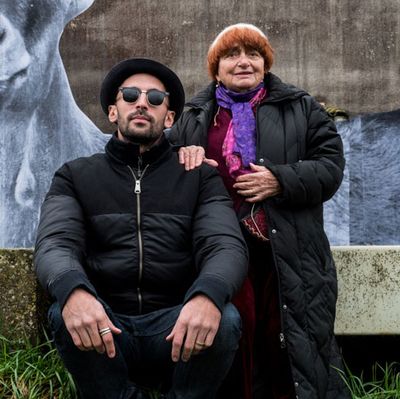
In this age of the constant first-person stream, practitioners of more time-intensive arts often find themselves on one side of a battle they didn’t necessarily sign up for. There’s a latent idea that independent filmmaking, documentary, investigative journalism, those old things called books — anything that requires us to flex our attention spans — are in a losing war with narcissism. That idea inevitably affects the experience of engaging with either — reading a long New Yorker story is “good for us,” spending half an hour trying to take the perfect selfie to convey your inner depths to your followers is a guilty pleasure at best.
So when the selfie arms come out in Faces Places, as they frequently do, it feels like a welcome recontextualization, and one coming from a legend of art cinema at that. Agnes Varda and her partner in crime, street artist JR, are pleasantly agnostic about our urge to whip out our phones every time something interesting happens, and downright reverent about the natural human urge to see our own image reflected back at us. Their film, a kind of improvised-feeling public-art tour crossed with a buddy road movie literally blows that idea up to giant proportions, as they tour the rural villages of France, covering their crumbling walls and craggy houses with the likenesses of the people who call them home.
There is a real sweetness to this film, especially in Varda and JR’s intergenerational chemistry, and its unfussy tone serves it well. In the opening minutes, Varda states her lifelong artistic mission to meet new faces and photograph them, and the composed, conflict-free interactions are a kind of fantasy of a world where you can go anywhere and be greeted with bemused curiosity at worst. Many of the areas Varda and JR visit are in the economically troubled regions of France’s rural north, but this being a staunchly apolitical film, such unpleasantries are never brought up. The country they travel through is filled with potential friends, and it’s a nice headspace to live in for an hour and a half.
The film goes through its cycle multiple times: The two artists hit the road in JR’s custom-built photo-booth truck, stop off in a town, chat to some of the locals, take their photos, then break out the scaffolding and erect their wheat-paste monuments. If that sounds like it could get repetitive quickly, you’re not exactly wrong. And because of the simplicity of the framing, a lot of the film’s effectiveness depends on how compelling you find JR’s work to be. Their first large-scale work, which involved wheat-pasting the likeness of the last remaining tenant of a condemned row of miners’ houses on her own brick façade, is deeply touching, and the woman’s reaction to the reveal of it is emotional gold, like something from a French street-art based HGTV show. That moment could exist on its own as a short film and convey the heart of what JR and Varda are after — the simultaneous joy and futility of trying to leave your mark on the place you call home.
But the film repeats this in such rapid-fire fashion, while the conversations with the portrait subjects become more and more perfunctory, that there can’t help but be diminishing returns. There is also a kind of willful naïveté that sticks out in some moments more than others, particular in a sequence in which the duo throw a party in the overgrown midst of a housing development whose construction was never finished (a telltale sign of economic strife across the European countryside). They state their purpose is to “bring life to the village, even for one day,” and proceed to wheat-paste the faces of locals on the half-finished ruins, with no mention of the preexisting, vibrantly colorful graffiti that already covered the cinder blocks. Faces Places mostly gets by on its insistent simplicity, but moments like this show the shortcomings of that approach.
The film is strongest when it looks the ephemerality of its endeavor dead in the eyes, particularly Varda’s, which are degenerating. Much has been made of the possibility that at 88, this could be her last film, and as a late-career meditation on what it means to capture a time and place in a still or moving image, it’s incredibly effective. The film’s best sequence takes place on the beaches of Normandy, where Varda tries to recreate a photo she took of a young, pre-fame Guy Bourdin. JR’s crew then sets to work trying to mount the original photo on the side of a German bunker, planted at a striking angle in the sand, where it landed after falling off the nearby cliffs. The juxtaposition — a toppled remnant of a violent regime, and a then-young artist who would be known for images as joyful as they were sinister — is satisfying and sad and resists easy summary.
And before anyone has a chance to try, it’s gone, washed away by the tide. “Ephemeral art is my stock in trade,” JR says wistfully, as we look upon the dark smear left on the concrete. But by the end of Faces Places you might find yourself asking, is there any other kind of art?

